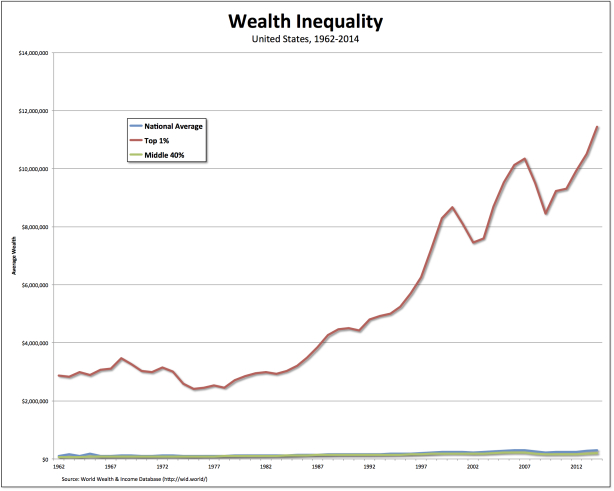From David Ruccio Wealth inequality in the United States has reached such extreme levels it is almost impossible to put it into perspective. But the folks at the Institute for Policy Studies (pdf) have found a novel way, by comparing the fortunes of the 400 wealthiest Americans to the meager assets of everyone else. Here’s what they found: The three wealthiest people in the United States—Bill Gates, Jeff Bezos, and Warren Buffett—now own more wealth than the entire bottom half of the American population combined, a total of 160 million people or 63 million households. America’s top 25 billionaires—a group the size of a major league baseball team’s active roster—together hold trillion in wealth. These 25 have as much wealth as 56 percent of the population, a total 178 million
Topics:
David F. Ruccio considers the following as important: Uncategorized
This could be interesting, too:
tom writes The Ukraine war and Europe’s deepening march of folly
Stavros Mavroudeas writes CfP of Marxist Macroeconomic Modelling workgroup – 18th WAPE Forum, Istanbul August 6-8, 2025
Lars Pålsson Syll writes The pretence-of-knowledge syndrome
Dean Baker writes Crypto and Donald Trump’s strategic baseball card reserve
from David Ruccio
Wealth inequality in the United States has reached such extreme levels it is almost impossible to put it into perspective.
But the folks at the Institute for Policy Studies (pdf) have found a novel way, by comparing the fortunes of the 400 wealthiest Americans to the meager assets of everyone else.
Here’s what they found:
- The three wealthiest people in the United States—Bill Gates, Jeff Bezos, and Warren Buffett—now own more wealth than the entire bottom half of the American population combined, a total of 160 million people or 63 million households.
- America’s top 25 billionaires—a group the size of a major league baseball team’s active roster—together hold $1 trillion in wealth. These 25 have as much wealth as 56 percent of the population, a total 178 million people or 70 million households.
- The billionaires who make up the full Forbes 400 list now own more wealth than the bottom 64 percent of the U.S. population, an estimated 80 million households or 204 million people—more people than the populations of Canada and Mexico combined.
Here’s another way: the average wealth of the top 10 billionaires (from the Forbes 2017 list) is $61 billion. In 2014 (the last year for which data are available), the average wealth for the United States as a whole (the blue line in the chart above) was only $297 thousand, while the average wealth owned by the middle 40 percent (the green line) was even less, $202 thousand. As for the top 1 percent, their average wealth (the red line) was $1.15 million—clearly far more than most other Americans but not even close to the extraordinary level of wealth that has been accumulated by the tiny group at the very top.
As the authors of the report explain,
The elite ranks of our billionaire class continue to pull apart from the rest of us. We have not witnessed such extreme levels of concentrated wealth and power since the first Gilded Age a century ago. Such staggering levels of wealth inequality threaten our democracy, compound racial and class divisions, undermine social cohesion, and destabilize our economy.
The problem is, while mainstream economists look the other way, politicians in Washington continue to allow the Monopoly men to pass Go, collect their additional billions in wealth, and win the game.
*”Monopoly men” are not just men: there are 50 women on the 2017 Forbes 400 list, who are worth a combined $305 billion. (An additional five women who built and share fortunes with their husbands also made the list.) They include Alice Walton (with a net worth of $38.2 billion), Jacqueline Mars ($25.5 billion), Laurene Powell Jobs ($19.4 billion), Abigail Johnson ($16 billion), and Blair Parry-Okeden ($12 billion).


